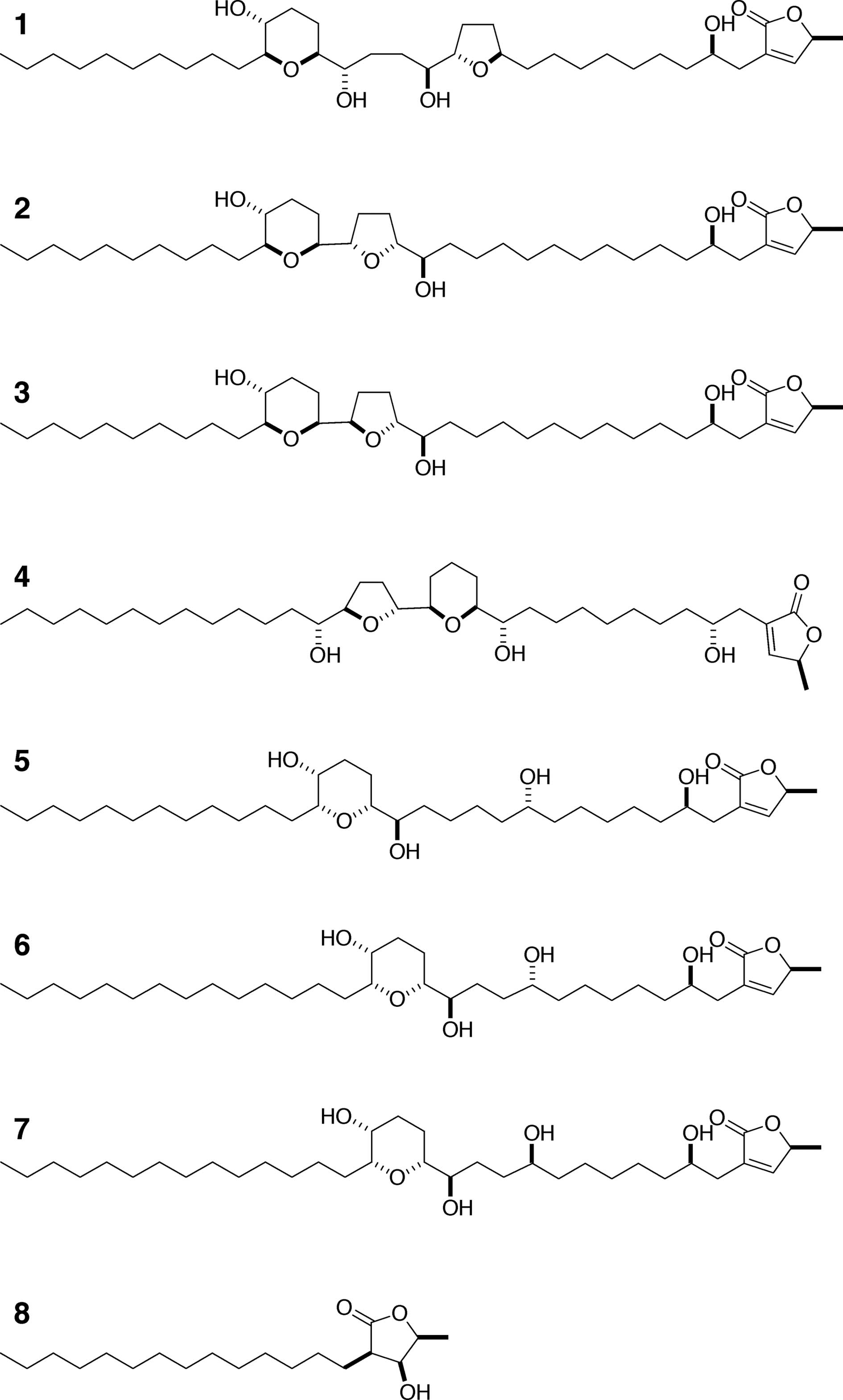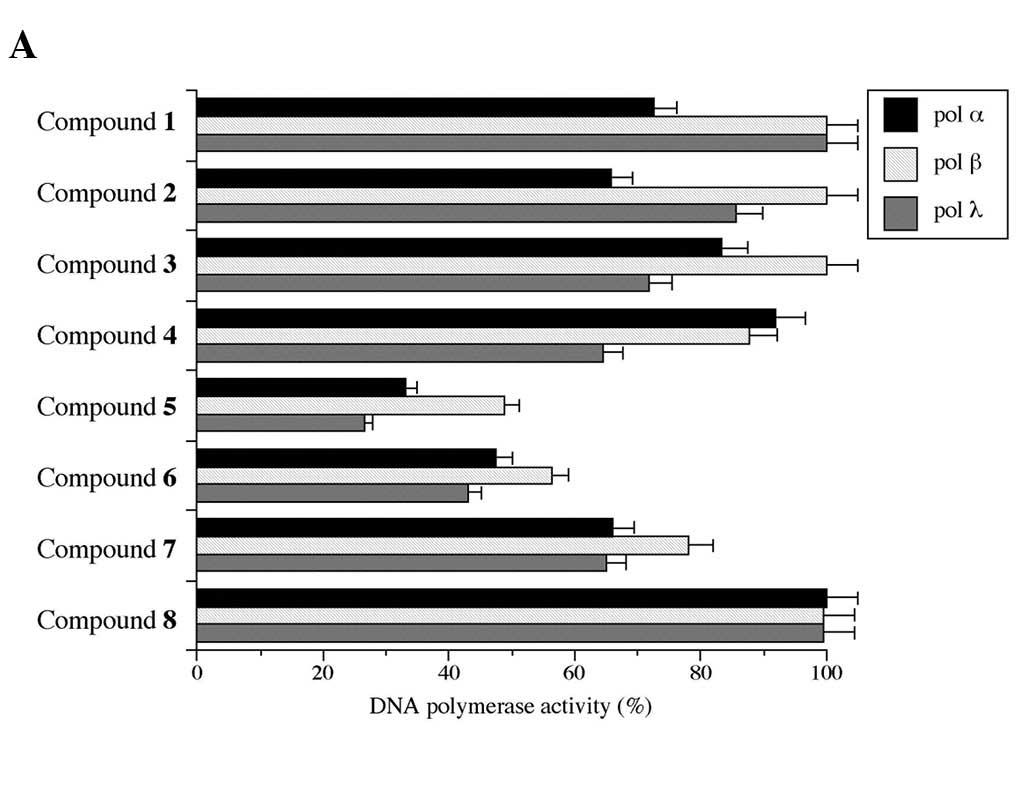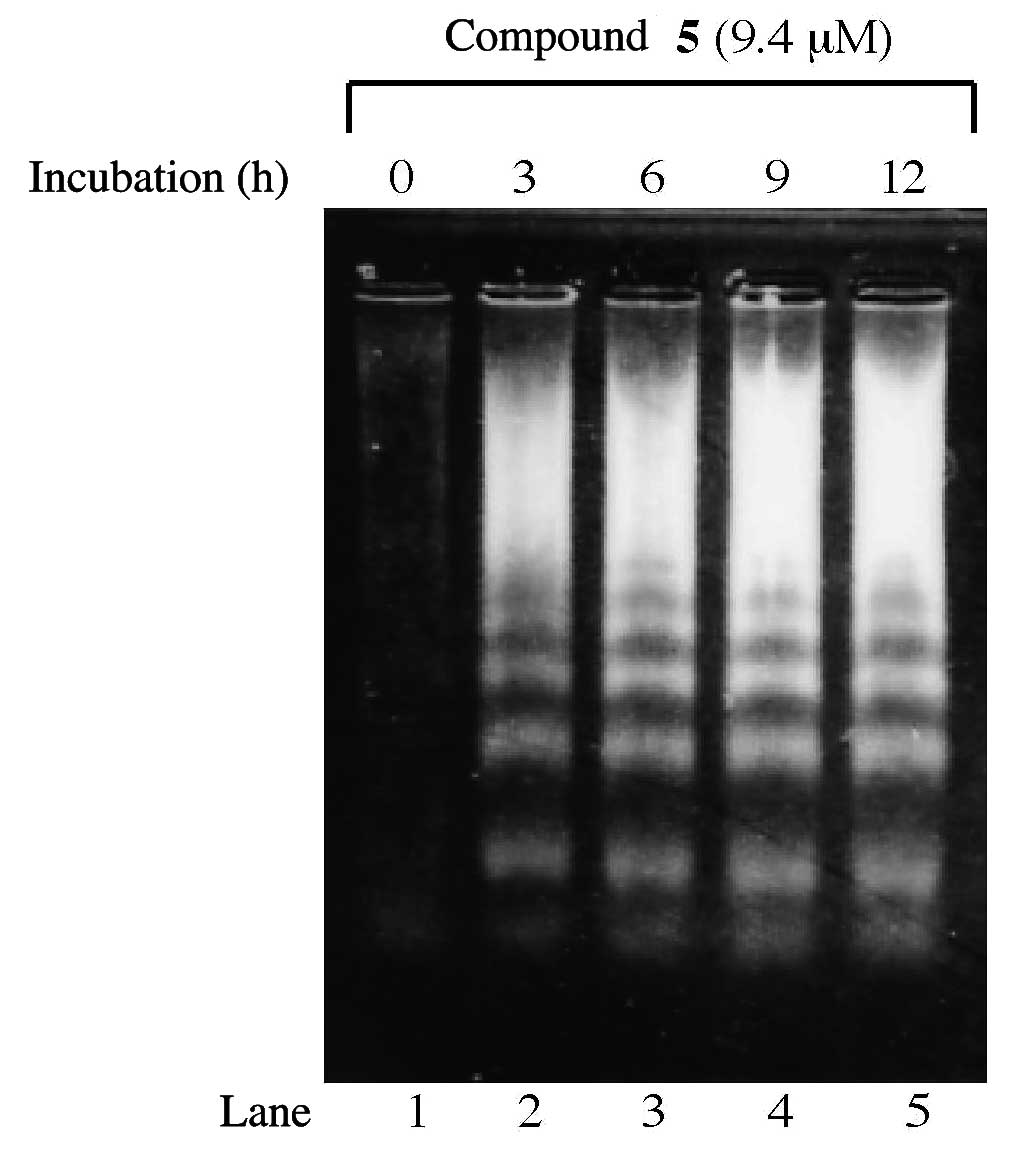|
1.
|
Rupprecht JK, Hui YH and McLaughlin JL:
Annonaceous acetogenins: a review. J Nat Prod. 53:237–278. 1990.
View Article : Google Scholar : PubMed/NCBI
|
|
2.
|
Alali FQ, Liu XX and McLaughlin JL:
Annonaceous acetogenins: recent progress. J Nat Prod. 62:504–540.
1999. View Article : Google Scholar : PubMed/NCBI
|
|
3.
|
Berrnejo A, Figadere B, Zafra-Polo MC,
Barrachina I, Estornell E and Cortes D: Acetogenins from
Annonaceae: recent progress in isolation, synthesis and mechanisms
of action. Nat Prod Rep. 22:269–303. 2005. View Article : Google Scholar : PubMed/NCBI
|
|
4.
|
Alali FQ, Rogers L, Zhang Y and McLaughlin
JL: Unusual bioactive annonaceous acetogenins from Goniothalamus
giganteus. Tetrahedron. 54:5833–5844. 1998. View Article : Google Scholar
|
|
5.
|
Chavez D, Acevedo LA and Mata R:
Jimenezin, a novel annonaceous acetogenin from the seeds of
Rollinia mucosa containing adjacent
tetrahydrofuran-tetrahydropyran ring system. J Nat Prod.
61:419–421. 1998. View Article : Google Scholar
|
|
6.
|
Shi G, Alfonso D, Fatope MO, Zeng L, Gu
ZM, Zhao GX, He K, MacDougal JM and McLaughlin JL: Mucocin: a new
annonaceous acetogenin bearing a tetrahydropyran ring. J Am Chem
Soc. 117:10409–10410. 1995. View Article : Google Scholar
|
|
7.
|
Shi G, Kozlowski JF, Schwedler JT, Wood
KV, MacDougal JM and McLaughlin JL: Muconin and mucoxin: additional
nonclassical bioactive acetogenins from Rollinia mucosa. J
Org Chem. 61:7988–7989. 1996. View Article : Google Scholar : PubMed/NCBI
|
|
8.
|
Kornberg A and Baker TA: Eukaryotic DNA
polymerase. DNA replication (2nd edition). Freeman WH and Co. (New
York). 197–225. 1992.
|
|
9.
|
Hubscher U, Maga G and Spadari S:
Eukaryotic DNA polymerases. Annu Rev Biochem. 71:133–163. 2002.
View Article : Google Scholar
|
|
10.
|
Bebenek K and Kunkel TA: DNA repair and
replication. Advances in Protein Chemistry. 69:Yang W: Elsevier.
(San Diego). 137–165. 2004.
|
|
11.
|
Takata K, Shimizu T, Iwai S and Wood RD:
Human DNA polymerase N (POLN) is a low fidelity enzyme capable of
error-free bypass of 5S-thymine glycol. J Biol Chem.
281:23445–23455. 2006. View Article : Google Scholar : PubMed/NCBI
|
|
12.
|
Wang JC: DNA topoisomerases. Annu Rev
Biochem. 65:635–692. 1996. View Article : Google Scholar
|
|
13.
|
Chakraborty AK and Majumder HK: Mode of
action of pentavalent antimonials: specific inhibition of type I
DNA topoisomerase of Leishmania donovani. Biochem Biophys
Res Commun. 152:605–611. 1988. View Article : Google Scholar : PubMed/NCBI
|
|
14.
|
Liu LF: DNA topoisomerase poisons as
antitumor drugs. Annu Rev Biochem. 58:351–375. 1989. View Article : Google Scholar : PubMed/NCBI
|
|
15.
|
Ray S, Hazra B, Mittra B, Das A and
Majumder HK: Diospyrin, a bisnaphthoquinone: a novel inhibitor of
type I DNA topoisomerase of Leishmania donovani. Mol
Pharmacol. 54:994–999. 1998.PubMed/NCBI
|
|
16.
|
Sakaguchi K, Sugawara F and Mizushina Y:
Inhibitors of eukaryotic DNA polymerases. Seikagaku. 74:244–251.
2002.PubMed/NCBI
|
|
17.
|
Pupo MT, Vieira PC, Fernandes JB and da
Silva MFGF: γ-Lactones from Trichilia claussenii.
Phytochemistry. 48:307–310. 1998.
|
|
18.
|
Takahashi S and Nakata T: Total synthesis
of an antitumor agent, mucocin, based on the ‘chiron approach’. J
Org Chem. 67:5739–5752. 2000.PubMed/NCBI
|
|
19.
|
Takahashi S, Kubota A and Nakata T:
Stereoselective total synthesis of mucocin, an antitumor agent.
Angew Chem Int Ed Engl. 41:4751–4754. 2002. View Article : Google Scholar : PubMed/NCBI
|
|
20.
|
Takahashi S, Maeda K, Hirota S and Nakata
T: Total synthesis of a new cytotoxic acetogenin, jimenezin, and
the revised structure. Org Lett. 1:2025–2028. 1999. View Article : Google Scholar : PubMed/NCBI
|
|
21.
|
Takahashi S, Kubota A and Nakata T:
Stereoselective total synthesis of muconin. Tetrahedron.
59:1627–1638. 2003. View Article : Google Scholar
|
|
22.
|
Takahashi S, Kubota A and Nakata T: Total
synthesis of a cytotoxic acetogenin, pyranicin. Org Lett.
5:1353–1356. 2003. View Article : Google Scholar : PubMed/NCBI
|
|
23.
|
Takahashi S, Ogawa N, Koshino H and Nakata
T: Total synthesis of the proposed structure for pyragonicin. Org
Lett. 7:2783–2786. 2005. View Article : Google Scholar : PubMed/NCBI
|
|
24.
|
Takahashi S, Hongo H, Ogawa N, Koshino H
and Nakata T: Convergent synthesis of pyragonicin. J Org Chem.
71:6305–6308. 2006. View Article : Google Scholar
|
|
25.
|
Takahashi S, Ogawa N, Sakairi N and Nakata
T: Stereoselective synthesis of
(2R,3S,4S)-3-hydroxy-4-methyl-2-tetradecyl-4-butanolide starting
from 2,5-anhydro-D-mannitol. Tetrahedron. 61:6540–6545. 2005.
View Article : Google Scholar
|
|
26.
|
Mizushina Y, Tanaka N, Yagi H, Kurosawa T,
Onoue M, Seto H, Horie T, Aoyagi N, Yamaoka M, Matsukage A, Yoshida
S and Sakaguchi K: Fatty acids selectively inhibit eukaryotic DNA
polymerase activities in vitro. Biochim Biophys Acta. 1308:256–262.
1996. View Article : Google Scholar : PubMed/NCBI
|
|
27.
|
Mizushina Y, Yoshida S, Matsukage A and
Sakaguchi K: The inhibitory action of fatty acids on DNA polymerase
β. Biochim Biophys Acta. 1336:509–521. 1997.
|
|
28.
|
Ishimaru C, Yonezawa Y, Kuriyama I,
Nishida M, Yoshida H and Mizushina Y: Inhibitory effects of
cholesterol derivatives on DNA polymerase and topoisomerase
activities, and human cancer cell growth. Lipids. 43:373–382. 2008.
View Article : Google Scholar : PubMed/NCBI
|
|
29.
|
Mosmann T: Rapid colorimetric assay for
cellular growth and survival: application to proliferation and
cytotoxicity assays. J Immunol Methods. 65:55–63. 1983. View Article : Google Scholar : PubMed/NCBI
|
|
30.
|
Murakami-Nakai C, Maeda N, Yonezawa Y,
Kuriyama I, Kamisuki S, Takahashi S, Sugawara F, Yoshida H,
Sakaguchi K and Mizushina Y: The effects of dehydroaltenusin, a
novel mammalian DNA polymerase α inhibitor, on cell proliferation
and cell cycle progression. Biochim Biophys Acta. 1674:193–199.
2004.
|
|
31.
|
Nishida K, Seto M and Ishida R: Different
susceptibilities of postmitotic checkpoint-proficient and
-deficient Balb/3T3 cells to ICRF-193, a catalytic inhibitor of DNA
topoisomerase II. Jpn J Cancer Res. 92:193–202. 2001. View Article : Google Scholar : PubMed/NCBI
|
|
32.
|
Degli Esposti M: Inhibitors of
NADH-ubiquinone reductase: an overview. Biochim Biophys Acta.
1364:222–235. 1998.PubMed/NCBI
|
|
33.
|
Oberlies NH, Chang CJ and McLaughlin JL:
Structure-activity relationships of diverse Annonaceous acetogenins
against multidrug resistant human mammary adenocarcinoma
(MCF-7/Adr) cells. J Med Chem. 40:2102–2106. 1997. View Article : Google Scholar
|
|
34.
|
Mizushina Y, Tanaka N, Kitamura A, Tamai
K, Ikeda M, Takemura M, Sugawara F, Arai T, Matsukage A, Yoshida S
and Sakaguchi K: The inhibitory effect of novel triterpenoid
compounds, fomitellic acids, on DNA polymerase β. Biochem J.
330:1325–1332. 1998.PubMed/NCBI
|
|
35.
|
Tanaka N, Kitamura A, Mizushina Y,
Sugawara F and Sakaguchi K: Fomitellic acids, triterpenoid
inhibitors of eukaryotic DNA polymerases from a basidiomycete,
Fomitella fraxinea. J Nat Prod. 61:193–197. 1998. View Article : Google Scholar : PubMed/NCBI
|
|
36.
|
Mizushina Y, Ohkubo T, Date T, Yamaguchi
T, Saneyoshi M, Sugawara F and Sakaguchi K: Mode analysis of a
fatty acid molecule binding to the N-terminal 8-kDa domain of DNA
polymerase β. J Biol Chem. 274:25599–25607. 1999.
|
|
37.
|
Mizushina Y, Sugawara F, Iida A and
Sakaguchi K: Structural homology between DNA binding sites of DNA
polymerase β and DNA topoisomerase II. J Mol Biol. 304:385–395.
2000.
|
|
38.
|
Mizushina Y, Iida A, Ohta K, Sugawara F
and Sakaguchi K: Novel triterpenoids inhibit both DNA polymerase
and DNA topoisomerase. Biochem J. 350:757–763. 2000. View Article : Google Scholar : PubMed/NCBI
|
|
39.
|
Mizushina Y, Ohkubo T, Sugawara F and
Sakaguchi K: Structure of lithocholic acid binding to the
N-terminal 8-kDa domain of DNA polymerase β. Biochemistry.
39:12606–12613. 2000.
|















